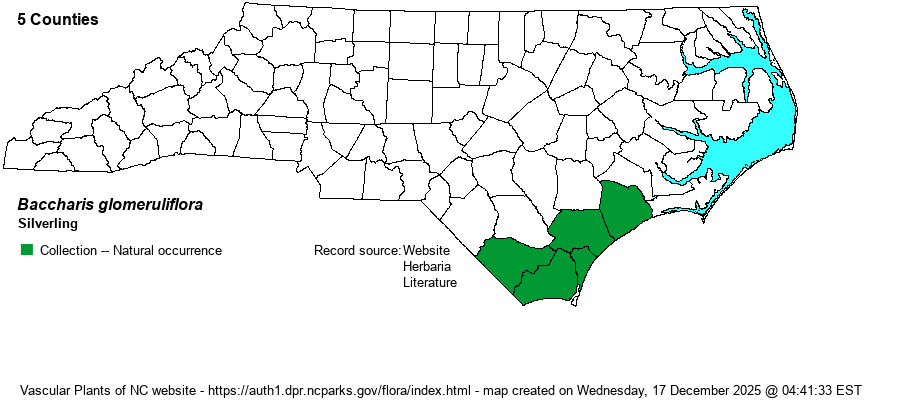| Author | Persoon | |
| Distribution | Specimens from the five most southeastern counties in the state, north to Onslow and Columbus. Currently known from Brunswick, Pender, and Onslow counties.
This species has quite a restricted distribution. It is found throughout FL, but it ranges north to southern NC mainly close to the coast. There are only a few scattered records from western FL to southern MS.
| |
| Abundance | Very rare in the state. Until a few years ago it was considered as historical, but there are several recent records, making this one of our rarest shrub species; two populations in eastern Brunswick County consist of well over 100 individuals each, and a few other apparently new sites (in 2019 and 2020) are documented with iNaturalist photos. This is a State Endangered species, as of May 2021. | |
| Habitat | Older state records were mainly from interdune swales and depressions very close to the coast. More recent records have been along small creek drainages and a damp area in a powerline clearing, in a savanna. Thus, it is a wetland species, found in sunny to partly sunny situations, occurring mainly in thickets or creek margins – somewhat ordinary and tiny wetlands that do not help the biologist searching for new locations of this rare species. | |
| Phenology | Blooms and fruits in October and November, and perhaps as early as late September. | |
| Identification | This is a small evergreen shrub that grows only to 3-6 feet tall. The leaves are small, mainly 1-1.5 inches long, light green and a bit glaucous, and are wedge-shaped, widening from a tapered base to show several serrated teeth at the broad tip. Though the leaves are fairly similar to those of the abundant B. halimifolia, B. glomeruliflora is separated from the other by its flowers in small clusters growing in axils along the stems, rather than solely near or at the tips of the branches. Thus, an observer seeing the species will note the creamy-yellow flowers or fluffy white fruit coming from all over the stems of this smaller shrub and not just around its perimeter. Its small stature might also be notable to an observer, especially a Baccharis shrub in bloom or fruit under 5 feet tall. Few biologists in the state are familiar with it in the Southeast, and thus it likely can be or will be overlooked by most people. | |
| Taxonomic Comments | None
| |
| Other Common Name(s) | Sessile-flowered Groundsel-tree. It is unfortunate that the Baccharis species in the Southeast do not have a collective group common name. Each of the three NC species has its own separate common name – and has quite a few disparate names -- that does not tie the group together within a given genus. Needless to say, Silverling is a “terrible” name that could refer to many plants and animals, such as fishes, but it is the one that has stuck in most references. | | State Rank | S1 | | | Global Rank | G4 | | | State Status | E | | | US Status | | | | USACE-agcp | FACW link | | USACE-emp | FAC link | |

